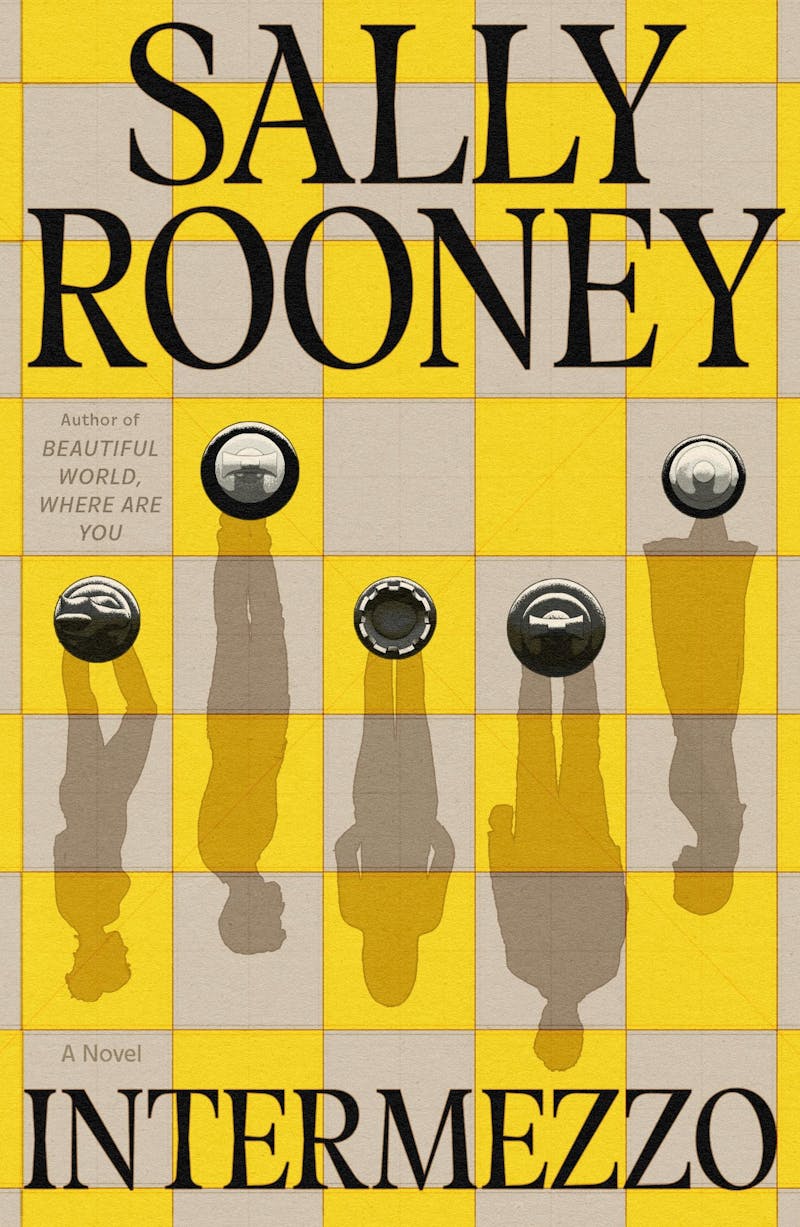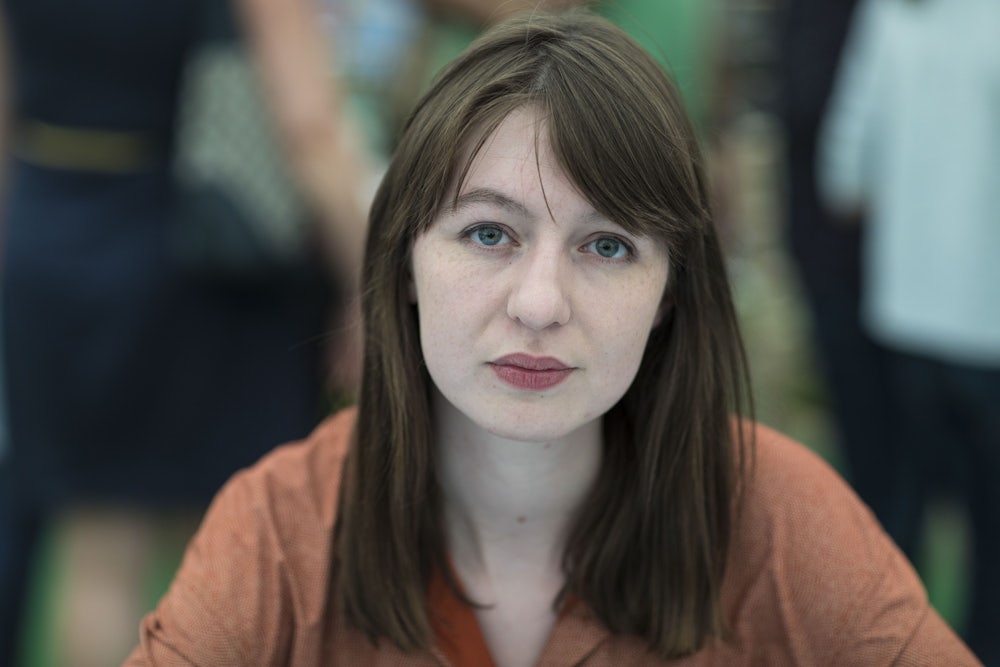Some of Sally Rooney’s best writing is about power in relationships: who has it and who doesn’t, who wishes they had it, and who has it but doesn’t know they do. Early on in Intermezzo, her fourth novel, she restages a scenario that will be familiar to readers of her debut, Conversations With Friends: A man gives 200 euros to the woman he is having sex with. The woman needs money, and the man has plenty of it. The man carefully does not give the 200 euros to the woman in exchange for sex; in Intermezzo, he transfers her the money and then performs ambivalence about when he’ll see her next, in “an effort to emphasize that he expects nothing in return for his money.” Nevertheless, both parties know they’ll sleep together again. Both know too that he’ll transfer her more money in the future.
The man wonders if their relationship is an exploitative one, prompting us—if we haven’t already—to wonder the same. If so, which party is being exploited? Does it make a difference that (in both novels) the man is 32 and the woman in her early twenties? Does it make a difference that he loves her? Does it make a difference that he’s married (Conversations With Friends) or simultaneously in love with someone else (Intermezzo)?

Rooney was in her early twenties when she wrote Conversations With Friends, which is narrated by the young woman. Throughout her career, Rooney has been celebrated as a specifically millennial novelist, and her novels have mostly focused on characters in their twenties as they come of age in the decade following the 2008 financial crisis. Her characters fall in love, fall out with friends, achieve literary success, and debate the relationship between their politics and their personal lives. The protagonists of Rooney’s last book, Beautiful World, Where Are You, were daunted by the approach of 30, though still wrestling with many of the same concerns.
Today, most millennials are solidly in their fourth decade—and in Intermezzo, the perspective of the young woman is closed off to us. We see her relationship only through the perspective of her older almost-boyfriend, Peter. Set in the immediate aftermath of Peter’s father’s death, this novel is Rooney’s most somber: more attentive to what can’t be undone or recouped, no longer convinced that success is just around the corner. Its characters learn to make peace with the world rather than dazzle it. The novel itself, the longest of Rooney’s books, lacks the dazzle of her previous works: Next to the tightness and momentum of Conversations With Friends and Normal People, it feels baggy and sometimes repetitive. Yet this bagginess allows Rooney to show how power operates not only within but also between relationships, as she follows the interplay of romantic and familial ties in the wake of grief and loss.
Peter Koubek is a brilliant junior barrister living in Dublin. The young woman he’s dating is Naomi, a beautiful student at risk of eviction, who occasionally makes money by posting explicit photos of herself online. But Peter is also in love with Sylvia, a brilliant academic (main characters in Rooney’s novels are usually brilliant or beautiful, sometimes both). Peter and Sylvia met at university, where—like Rooney herself—they were debating champions. They had a blissfully happy relationship until, at 26, Sylvia was in a road accident that left her with chronic and often excruciating pain, and an inability to have penetrative sex. Not long after the accident, Sylvia broke up with Peter, who has since had a parade of hot girlfriends, culminating in Naomi. Sylvia and Peter, meanwhile, have continued to be best friends. When the novel opens, they’ve just started semi-chastely sharing a bed.
The relationship between Peter and Naomi is mirrored by the relationship between Peter’s younger brother, Ivan (aged 22) and sensible, self-contained Margaret (age 36). Ivan, who wears braces and has just finished a degree in theoretical physics, was a chess prodigy. He hasn’t been playing quite as well as he used to, but he’s still good enough to triumph in a competition at the rural arts center where Margaret works. As soon as the two meet, they have a powerful sense of belonging together, despite Ivan’s awkwardness and Margaret’s ignorance of chess. Their ensuing romance is troubled only by Margaret’s qualms about their age gap.
The third millennial–Gen Z relationship in the novel is between Peter and Ivan, whose different ages have shaped their different experiences of family life: their parents’ separation, their mother’s new family, their father’s cancer and death. Yet Rooney has little interest in generational stereotypes. There are a couple of mentions of Ivan’s teenage flirtation with incel ideology, and Peter and Naomi joke about the sexual proclivities of Gen Z (“You’re all going around getting strangled and spitting in each other’s mouths or whatever. I’m thirty-two, okay, we’re normal”), but that’s it. Instead, the novel offers an uneven study of what a person might gain or lose in their first decade or so post-college.
Peter, Margaret, and Sylvia, the novel’s thirtysomethings, have a financial stability that Ivan and Naomi lack. All three can afford to live alone (Rooney knows, of course, that this is not the case for many millennials; knows too that housing is a form of power one can wield or imperfectly share within a relationship). But even living alone can be a mixed blessing: When Ivan tells Margaret, the first time he visits her cottage, that “it’s cool” she gets to live by herself rather than with roommates, her reply—“Right … I suppose—It wasn’t what I had planned for my life”—neatly shows how the significance of living alone can shift with age.
Beyond housing stability and some measure of professional satisfaction, Rooney doesn’t have much to say in favor of getting older. The struggles the older characters have experienced in their late twenties and early thirties have made them guarded and fearful. Peter ruminates endlessly on his former relationship with Sylvia and his past achievements; he cannot admit the strength of his feelings for Naomi or of his grief for his father. He intermittently combines too much alcohol with various pills and thinks about suicide.
Scarred by the recent breakdown of her marriage, Margaret is terrified of how friends and family—even how disliked acquaintances—will judge her if they hear about her relationship with Ivan. Peter is likewise motivated by fear of the judgment of others, and a desire to seem normal—not to be lumped in with “those unnerving moon-faced people, the polyamorous, fetishists, and so forth.… With all due respect he would rather drop dead.” Sylvia’s pride gets in the way of her having a sexual relationship with Peter, given how such a relationship would be shaped by her physical constraints. She’d rather he just “remember [her] the way [she] was.”
By contrast, Ivan and Naomi seem sure of themselves and what they want. The regrets that they have, they face head-on. Perhaps they simply have less to lose, but there’s an admirable honesty in Rooney, a novelist in her early thirties who wrote her first book in her early twenties, suggesting that the passing of a decade might diminish rather than increase a person’s insight.
Critics have compared Rooney’s novels to nineteenth-century marriage plots and, less favorably, to Twilight and Fifty Shades of Grey—with all the emphasis on happy endings those comparisons imply. Intermezzo, too, works its way toward the removal of misunderstandings and the establishment of romantic and fraternal harmony. Along the way, as in her previous novels, there’s plenty of emotionally intense and mutually pleasurable sex.
The compulsive quality of Rooney’s earlier works, which can be read in a day or two, has as much to do with the clarity and attentiveness of her style as with the on-again, off-again plots they narrate. Here, this style is in evidence when she writes from the perspective of Ivan and Margaret. It suits their honesty with one another as well as Ivan’s methodical, analytical nature.
In the Peter-Sylvia-Naomi sections of the book, which have the most typically Rooney relationship arc, a different style operates. These sections, all from Peter’s perspective and in close third person, have a Joycean compressed and inverted syntax. Here’s Peter accompanying Sylvia to the hospital:
Morning he waited at the hospital while she had the procedure. Nurse came in to tell him when they were finished with her. Recovering from her sedative under the bleach-white lighting she looked thin and tired. Tea they had given her in a plastic cup, and dry toast.… Felt overcome looking. Small and frail in her patterned gown.
The fragmentation is fitting for a character who peers at his life through his fingers—but I didn’t find the extra work it requires of the reader to be worth the reward. Peter’s self-pity and his flattening of both Sylvia and Naomi—one the “high principle of his conscience,” the other with an “animal intelligence”—make it hard to care about his relationship with either. When the two women are finally allowed to give their sides of the story, they show an unnerving good humor and perspicacity. Their forbearance makes possible a too-neat resolution to their troubles: The demands of a happy ending flatten them just as much as Peter’s perspective does.
The other relationships in the novel are fresher and more successful. Ivan and Margaret’s peaceful love affair is a departure from the fizzy romances of Rooney’s previous novels, and from the marriage plot genre as a whole. It’s remarkable that she can make something virtually frictionless so absorbing. Ivan and Margaret’s interest in one another, and to the reader, builds through a series of conversations that reveal difference rather than disagreement: their different attitudes toward God, work, and risk; the different experiences that condition their understanding of themselves and their possible future together.
Ivan’s tumultuous relationship with Peter, as both struggle with grief for their father, connects the two halves of the book. Rooney has written about siblings before: Marianne’s abusive brother in Normal People, Eileen’s spiteful sister in Beautiful World. But these relationships existed at the peripheries of their novels. By focusing on the Koubek brothers and their bond, Rooney sets herself the challenge of animating a relationship that matters to the two people involved in it only because of their shared past. Ivan and Peter are very different, and not in ways that are particularly compatible. Together they have none of the ease or spark that each has with their girlfriend; at best, they’ll achieve mutual sympathy, not intimacy. Nevertheless, Rooney expresses what the brothers themselves cannot: the importance of each to the other, and how the decade between them has at once maintained and limited their connection.
In these distinctive relationships, the kind that rarely occupy the center of novels, Intermezzo excels. The novel’s conclusion, with all five characters content and reconciled with one another, does a disservice to its messy middle, in which Rooney depicts the unshowy, awkward, or unsolvable. The result is a work that’s less coherent, and less purely enjoyable, than her others—but one that hints at an author working her way to something new.
